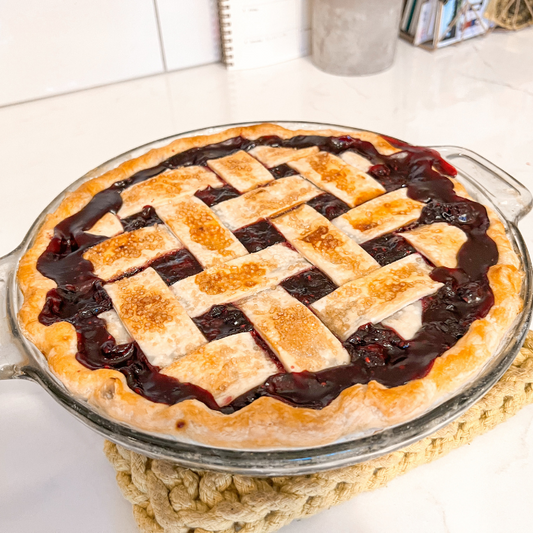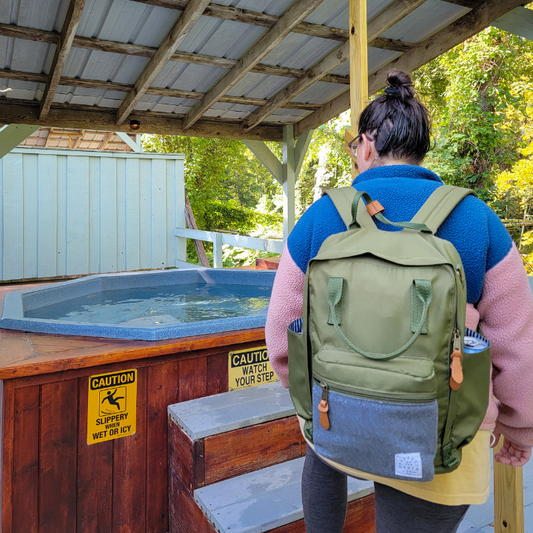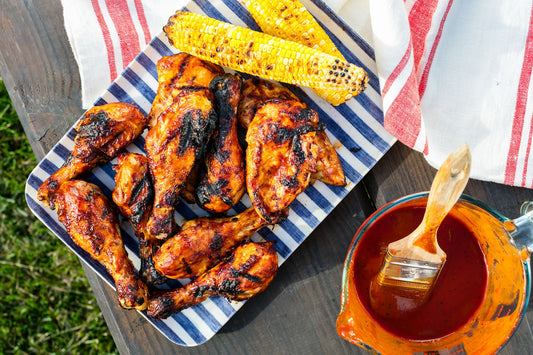Can we get completely real for a second? Having a baby is hard work. From all the options that are involved in feeding, clothing, diapering, and caring for your child to all the added pressure of ensuring they are hitting milestones on time and staying as safe as possible in every situation, parents are constantly juggling advice and research with natural instincts and personal morals to ensure their children live the best lives possible in every single aspect of their worlds.
As parents ourselves, we get it. It’s hard to believe that such a sweet, adorable newborn baby can turn into an adventure-seeking toddler in the blink of an eye. But, take it from us- a baby can get into trouble pretty quickly.
The best advice we can give is to make sure your home is baby-proofed for all the explorations ahead. From your kitchen and living room to your bedrooms and bathrooms, keeping your child free from injury at home can be a lot less problematic with the right baby-proofing tactics and plan in place.
Let’s dive into some of our must-do baby-proofing ideas to implement today.

Baby-proofing Your Home
Time is of the essence when it comes to preparing your home for the crawling and exploring stages. Although it may feel like your newborn is too young to get into anything just yet, it is important to understand and develop a plan around baby-proofing your specific home.
Each year 3.5 million children end up in the emergency room due to injuries sustained at home. Of that, nearly 2,200 children die each year from at-home injuries. Suffocation, drowning, fires and burns, and falls account for most in-home fatalities.
Now, we aren’t telling you this to create a sense of fear or worry in your heart. We want you to be informed and educated on making the right choices at home to keep your child free from harm. Baby-proofing your home is key to reducing your child’s risk of injury and keeping them safer all around.

Baby-Proof The Kitchen
The kitchen is often referred to as the heart of the home. It is the place where you and your family spend countless hours cooking, chatting, and enjoying mealtime together. Although a safe haven for togetherness, the kitchen can be a big obstacle for toddlers and young children to face, especially when it comes to potential injuries that could occur at the hands of utensils, appliances, and other hazards.
When looking at it from a baby-proofing standpoint, the kitchen is actually one of the most dangerous spots for children. With countless chemicals, hot ovens, easy-to-reach stovetops, and sharp utensils, the risks are heightened in the kitchen.
Some of the most common kitchen-related injuries children face include:
- Burns
- Fires
- Ingestion of chemicals from household cleaners
- Cuts from sharp objects like knives
- Slips and falls
How to Baby-Proof Your Kitchen
Although most of the objects that cause harm are essential pieces in the kitchen, there are various ways to baby-proof the space to meet the needs of your growing family. Some of the best ways to baby-proof your kitchen include:
- Add child proof locks to all cabinets and drawers, especially those containing harmful household chemicals.
- Add stovetop burner covers and knob locks to prevent children from touching stovetops and turning stove and oven knobs to an on position.
- Lay down nonskid pads underneath all area rugs in the dining and kitchen areas to prevent slips.

Baby-Proof The Living Room
The living room is often synonymous with relaxation, right? It’s the spot we plop ourselves down in after a long day at the office or on the run, or a place we gather together to enjoy holidays, family time, and movie nights. Although, as adults, we think of it as the ultimate cozy corner of our home, it is a different story for babies, toddlers, and young children on the move. For them, the living room is an opportune place to climb, jump, tumble, and explore all things.
From bookshelves to electronics, outlets, blind cords, and sharp corners, various dangers need to be mitigated before you let your child loose.
How to Baby-Proof Your Living Room
According to the U.S. Consumer Product Safety Commission, nearly 22,500 people are seen in emergency departments each year from injuries caused by furniture and TV tip-overs, of which 44% of them are children. Secure your TV to the wall using a wall mount or place it on a low table away from the edge. Anchor furniture, such as bookshelves, to the wall to avoid the risk of tip-overs.
Here are some other ways to baby-proof your living room:
- Add corner cards to all furniture with sharp edges, especially coffee or side tables.
- Place outlet covers in all outlets.
- Avoid storing items, such as toys, where kids need to climb to reach them.
- Store heavier items on lower shelves.
- Keep all cords out of eyesight and reach of children.
- Opt for cordless blinds to eliminate the risk of any strangulation hazards.
- Place non-slip pads under all area rugs.
- Remove any old, shaky furniture.
- Get rid of all high-risk accessories like glass vases, or large lamps.
- Add latches to any drawers and doors.
If your living room includes stairs to the upper floor or lower basement, it is important to reduce the risk of falls by baby-proofing that area as well. Nearly 255 children under the age of 5 go to the emergency room daily for fall-related injuries due to staircases. Don’t become part of that statistic, instead, baby-proof the stairs by using safety gates at both the top and bottom of the stairs.

Baby-Proof The Bathrooms
Bathrooms are the prime location to store medicines, vitamins, and other health-related items, especially when they come with built-in medicine cabinets. One of the biggest risks to children is coming into contact with medication and other potentially fatal chemicals in the bathroom.
Aside from getting into medication in the bathroom, water-related injuries are most common. From a water temperature that is too hot for babies to the risk of drowning, keeping a careful watch on your children in the bathroom is essential to their overall safety.
How to Baby-Proof Your Bathroom
The best ways to baby-proof the bathroom include:
- Adding secure latches and locks to all medicine cabinets.
- Securing all household and bathroom cleaning supplies in a cabinet that is locked and out of reach of children.
- Keeping a thermometer on hand to measure the temperature of the bathwater before placing your child in the tub.
- Adding a lock to your toilet cover.
It is important to recognize that drowning is the leading cause of injury-related death in the home amongst children between the age of 1 and 4. To eliminate this risk, never leave your child unattended in the bathtub or shower for any length of time. It only takes a few seconds for a child to drown.

Baby-Proof The Nursery
From mid-morning naps to playtime and bedtime, a child spends a lot of time in their nursery throughout the day. Although considered a safe haven for your child and a starting place for their growth, the nursery can have various hazards that could potentially harm your child if not taken care of promptly.
The good news is that you can baby-proof your nursery during the nesting stage of pregnancy. It is never too early to start making your home a safe place for your new child.
Whether you’ve just started decorating your nursery or are hoping to make it more baby-friendly as your child grows, the most important factor to consider is this: functionality and safety matter most. Although themed decor and comfy essentials add a sense of warmth to the space, make sure that all elements within your nursery are there to keep your child safe and prevent injury.
The most common injuries seen from time in the nursery include:
- Falls
- Scrapes and bruises
- Hand and finger injuries caused from jams in doors, drawers or other bins.
How to Baby-Proof Your Nursery
The best tips for baby-proofing the nursery are as follows:
- Do not hang anything directly over the crib or changing table. Tiny hands can easily grab these and pull them down onto themselves causing abrasions, bruises, or severe injury.
- Opt for a thick carpet or mat to help alleviate the injury that can come with a fall.
- Choose a toy box with an open-top as lids can cause injuries to fingers, toes, or other body parts.
- Add security latches to drawers, bins, and closet doors.
- Cover all sharp edges and corners with bumpers or safety padding.
- Insert outlet covers into all open outlets.
- Keep any cords out of a child’s reach.
- Consider cordless blinds.
- Do not fill a baby’s crib with heavy blankets, pillows, or stuffed animals as they increase the risk of suffocation during sleep.
- Choose age-appropriate toys and simplistic decor elements to avoid the risk of choking on objects that they could easily come in contact with.

Baby-Proof The Backyard
Your backyard should be your personal oasis, not a danger zone for growing children. Although everyone’s backyard is laid out a bit differently, there are various ways to baby-proof the area to keep your children safe.
The most common injuries in the backyard for babies and toddlers include:
- Falls from swing set equipment
- Bruises and sprains from outdoor toys and furniture
- Burns from outdoor firepits, grilling equipment, or the sun
- Water-related injuries in backyards that contain a pool
How to Baby-Proof Your Backyard
Here are our top tips for baby-proofing your backyard area:
- Properly fence in any pools.
- Cushion sharp corners on outdoor furniture.
- Block off any water features from a child’s direct access.
- Keep all garden hoses out of the sun.
- Avoid dangerous plants that could be toxic or harmful to your child.
- Check all playground equipment regularly to ensure it is sturdy and safe to play on.

Baby-Proofing FAQs
Whether you’re a first-time parent or a self-proclaimed veteran of many children hoping to make your home a safer place for children of all ages, understanding exactly how to baby-proof your home is essential to mitigating the risk of injuries and fatalities for all.
Here are some of the most frequently asked questions when it comes to baby-proofing, along with answers to help you turn your home into a safe and secure place for your children.
How much does it cost to baby-proof a house?
The cost of baby-proofing your home depends on various factors including home size and specific baby-proofing needs. The average cost to baby-proof your home is between $500 and $2500, with most parents paying around $1500 to secure their home for their child.
Costs typically include essential items for each room like baby gates, outlet plugs, furniture anchors, electrical and anti-burn protection covers and materials, and drawer, latch, and door locks.
When do I need to start baby-proofing my house?
Although children aren’t instantly mobile, baby-proofing your home should begin before the hectic “on-the-move” stage kicks into full gear. You can start baby-proofing your home as early as the second or third trimester of pregnancy to as late as four or five months postpartum. However, we encourage you to begin sooner so that your home is ready to go when your child is ready to take their first crawls (and steps!) forward to explore all the adventures your home has in store for them.

Key Takeaways on How To Baby-proof Your Home
We know that your baby’s health is your top priority because it’s ours, too. At Product of the North, we believe in giving the parenting community a safe haven to go to when they need products for their growing family that support their goals of keeping their babies safe and cared for. We also know that baby-proofing is an essential part of your child’s first year of life and beyond. We’ve lived it, and we are here to support you every step of the way.
As you begin to buy all the crucial pieces to keep your home safe, focus on critical areas like the kitchen, bathroom, nursery, living room, and outdoors. Pay particular attention to areas that could increase their risk of injuries, such as stairs, near appliances, and rooms containing chemicals or medications that could be harmful if ingested.
The bottom line? Reducing the risk of injuries and fatalities starts at home. So take ownership of that idea and begin protecting your baby today. We suggest taking a room-by-room approach to safeguarding your home against the risks that come with a baby and toddler exploring their surroundings.
For more helpful advice, we recommend checking out the following:
- 33 Eco-Friendly Home Tips
- Best Sustainable Baby Products
- Raising Eco-Friendly Kids
- How To Change A Diaper When Traveling
- How To Swaddle A Baby
- Breastfeeding Tips & Tricks




